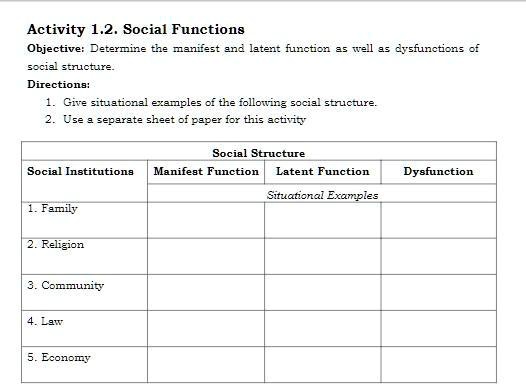Imagine you walk into a busy coffee shop, drawn by the aroma of freshly roasted beans and the promise of a caffeine boost. You order your latte, grab a comfy seat, and settle in to enjoy your morning ritual. What you might not realize is that you’re participating in a complex social system with hidden functions beyond just getting your caffeine fix. This coffee shop, like many aspects of our lives, operates on both visible and invisible levels, shaping our experiences in ways we may not even recognize.

Image: www.numerade.com
Welcome to the world of manifest functions and latent functions, two sociological concepts that shed light on the complex ways societies function and how our everyday actions contribute to a larger social order. These functions, often intertwined and sometimes surprising, help us understand why things are the way they are and how our choices ripple through the fabric of society, impacting everyone around us.
Understanding the Building Blocks of Social Reality
At its core, sociology seeks to analyze social structures, the organized patterns of behavior and relationships within societies. These structures are the frameworks that give shape to our lives, guiding our actions and interactions. Within these structures, social functions are essential, as they contribute to the stability and continuity of society.
Manifest functions are the intended and observable consequences of social structures. They are the explicit purposes and goals that are openly recognized and intended by participants. Think of manifest functions as the tip of the iceberg: the readily apparent reasons for something’s existence. For example, the manifest function of a school is to educate students.
Latent functions, on the other hand, are the unintended and often hidden consequences of social structures. They are the unanticipated outcomes that emerge alongside the manifest functions, sometimes even contradicting them. Picture latent functions as the unseen depths beneath the surface of the iceberg, influencing the social landscape in subtle and powerful ways.
The Power of Unforeseen Consequences
Let’s delve deeper into the concept of latent functions with a few real-world examples:
- Education: While the manifest function of education is to impart knowledge and skills, the latent function might be to socialize students into societal norms and values, promoting social cohesion and citizenship.
- Religion: The manifest function of religion might be to provide moral guidance and spiritual comfort, but its latent function can include fostering community, social control, and even political influence.
- Marriage: The manifest function of marriage is to legitimize and formalize relationships, but its latent function can include creating social networks, providing economic stability, and raising children.
The examples above demonstrate how seemingly simple social structures can have far-reaching consequences, shaping our values, beliefs, and behaviors in ways we might not initially recognize.
The Dynamic Dance of Manifest and Latent Functions
It’s crucial to understand that manifest and latent functions are not mutually exclusive. They often coexist and even influence one another. For example, the manifest function of a hospital is to provide medical care, but its latent function might also involve creating jobs for medical professionals, fostering social connections through support groups, and even influencing public health policy.
The interplay between these functions can lead to complex and sometimes paradoxical outcomes. A social structure can have both positive and negative latent functions. While education can promote social cohesion, it can also unintentionally reinforce social inequalities if it’s not accessible to all members of society.

Image: keplarllp.com
The Ripple Effect: Recognizing the Widespread Impact
The concepts of manifest and latent functions highlight the interconnectedness of social structures and the ripple effect of our actions. Every institution, organization, and even our everyday routines contribute to a larger social system, playing a role in maintaining or transforming society. By understanding these functions, we can gain a more nuanced perspective on the forces that shape our world.
Applying the Concepts: Making a Difference
So, what can we do with this knowledge of manifest and latent functions?
- Critical Thinking: By recognizing the latent functions of social structures, we can develop a more critical perspective and identify potential issues or unintended consequences.
- Social Change: Our understanding of latent functions can empower us to advocate for change and address inequalities that might be overlooked if we only focus on manifest functions.
- Personal Growth: By analyzing the social structures in our own lives, we can become more aware of our own roles and contributions within society, leading to more conscious decisions and responsible actions.
Manifest Function And Latent Function
https://youtube.com/watch?v=LcluY6UsVXY
Conclusion
The world we live in is a tapestry woven with countless social structures, each with its own set of manifest and latent functions. Understanding this interplay between the visible and the hidden is essential for navigating our complex social landscape effectively. By recognizing both the intended and unintended consequences of social structures, we can become more informed citizens, promoting social change and contributing to a more just and equitable world.
So, the next time you find yourself in a crowded coffee shop, remember, you’re not just grabbing a latte, but engaging in a social ritual with complex, interwoven functions that impact your life and the lives of those around you. And as you delve deeper into the world of sociology, continue to explore the hidden meanings of the social structures that shape our experiences.






